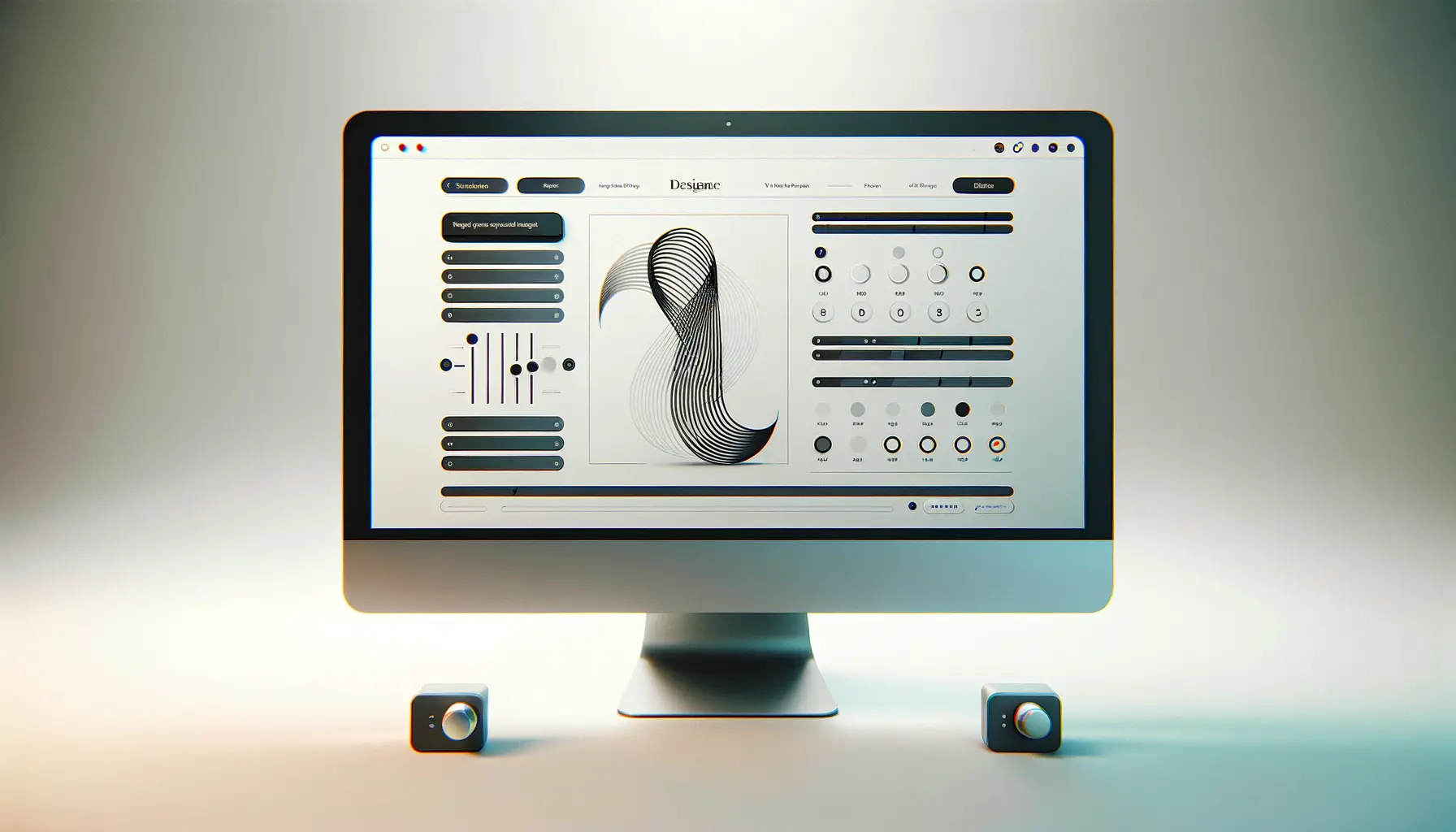The influence of trendy fonts on web design decisions cannot be overstated.
As the digital landscape continues to evolve, the choice of font has become a critical element in creating engaging, user-friendly websites.
Fonts are not just a means of displaying text; they are a powerful tool that can significantly affect a website’s aesthetic appeal, readability, and overall user experience.
The right font can convey a brand’s personality, evoke emotions, and even influence consumer behavior.
This article delves into the intricate relationship between trendy fonts and web design, offering insights into how these stylistic choices shape the digital world.
In the realm of typography, the term “trendy” often refers to fonts that capture the zeitgeist, blending contemporary aesthetics with functional design.
These fonts are at the forefront of design innovation, pushing the boundaries of traditional typography to create visually compelling digital experiences.
The selection of a trendy font is a strategic decision that goes beyond mere aesthetics; it involves considering the font’s impact on usability, accessibility, and the overall message the website intends to convey.
By exploring the role of trendy fonts in web design, we uncover the nuances of how typography influences the digital environment and user interaction.
- The Significance of Font Choice in Web Design
- The Evolution of Trendy Fonts in Digital Spaces
- Typography and Brand Identity
- Choosing the Right Font for Your Website
- Impact of Trendy Fonts on SEO and Accessibility
- Integrating Trendy Fonts with Responsive Design
- Future Trends in Typography and Web Design
- Embracing the Future of Typography in Web Design
- FAQs on Trendy Fonts and Web Design Decisions
The Significance of Font Choice in Web Design
Creating a First Impression
The choice of font is one of the first elements that catch a user’s eye when they visit a website.
It plays a pivotal role in shaping the first impression, setting the tone for the user’s experience.
A trendy font can immediately convey modernity and innovation, suggesting that the brand is up-to-date with current design trends.
This initial perception is crucial, as it can determine whether a user decides to engage further with the website or leave.
The right font choice can make a website appear more professional, trustworthy, and appealing, encouraging users to explore its content.
Moreover, the emotional impact of font choice cannot be underestimated.
Different fonts can evoke different feelings and associations.
For instance, a sleek, minimalist sans-serif font may convey a sense of sophistication and cleanliness, ideal for luxury brands or tech companies.
On the other hand, a hand-drawn script font might evoke warmth and personal touch, suitable for boutique shops or personal blogs.
The ability of a font to align with a brand’s identity and values is a testament to its power in web design.
Enhancing Readability and User Experience
Aside from aesthetics, the functionality of a font is paramount in web design.
Trendy fonts must not only be visually appealing but also highly readable across various devices and screen sizes.
Readability directly influences the user experience, determining how easily users can consume content on a website.
A well-chosen font facilitates smooth navigation and interaction, leading to a more satisfying and efficient user experience.
It’s essential to select fonts that are legible in different contexts, including long paragraphs, headings, and buttons, to ensure that users can access information without strain.
Furthermore, the choice of font can affect a website’s accessibility.
Designers must consider users with visual impairments or reading difficulties, selecting fonts that are clear and easy to decipher.
Incorporating trendy fonts that also prioritize readability and accessibility demonstrates a commitment to inclusive design, broadening a website’s reach and making it welcoming to a diverse audience.
The strategic selection of trendy fonts is a crucial aspect of web design, influencing first impressions, brand perception, readability, and accessibility.
The Evolution of Trendy Fonts in Digital Spaces
The digital era has witnessed a remarkable evolution in the use of fonts, with trends shifting from the classic serifs to the sleek and minimalist sans-serifs, and now to more dynamic and expressive typefaces.
This evolution reflects the changing tastes and technological advancements, showcasing how fonts adapt to meet both aesthetic preferences and functional needs in digital spaces.
Initially, web design was limited by technological constraints, leading to the dominance of a few web-safe fonts.
However, as technology advanced, designers gained the freedom to experiment with a wider array of typefaces, ushering in an era of typographic diversity and creativity.
The introduction of font embedding services and responsive design techniques has further expanded the possibilities, allowing for the use of custom and trendy fonts that enhance brand identity and improve user engagement.
From Function to Fashion
The transition from purely functional fonts to those that also serve as fashion statements marks a significant shift in web design priorities.
Designers now recognize the potential of fonts to serve as a key component of a brand’s visual identity, similar to a logo or color scheme.
This has led to the selection of fonts that not only convey information but also embody the brand’s personality and values.
- Web-Safe Fonts: The early days of web design were dominated by a handful of fonts considered “web-safe,” ensuring consistent display across different browsers and operating systems.
- Responsive Typography: The rise of mobile browsing necessitated fonts that are legible and appealing on smaller screens, leading to the adoption of responsive typography practices.
- Custom Typefaces: Brands increasingly commission custom fonts to differentiate themselves in a crowded digital landscape, tailoring their typographic voice to match their unique identity.
Impact on User Engagement
The evolution of font trends has had a profound impact on user engagement.
Trendy fonts can captivate users’ attention, making content more interesting and engaging.
The choice of a unique or custom font can turn an otherwise mundane website into a memorable experience, encouraging users to spend more time exploring the content.
- Increased Time on Site: Attractive and readable fonts can significantly increase the time users spend on a website, enhancing the chances of conversion.
- Improved Readability: The shift towards fonts that prioritize readability on various devices has improved the overall user experience, making content more accessible to a wider audience.
- Brand Recognition: Using distinctive fonts helps in building brand recognition, as users begin to associate certain typographic styles with specific brands.
The evolution of trendy fonts in digital spaces reflects the balance between aesthetic appeal and functional utility, significantly influencing user engagement and brand identity.
Typography and Brand Identity
The intricate relationship between typography and brand identity is pivotal in the realm of web design.
Fonts do much more than simply display content; they are an essential component of a brand’s visual identity, conveying the brand’s personality, values, and overall message to its audience.
The choice of typography can make or break a brand’s digital presence, influencing how it is perceived by potential customers and distinguishing it from competitors.
When a brand selects a font, it’s choosing a voice for its online communications.
This voice must be consistent across all platforms and mediums to ensure brand recognition and coherence.
A well-chosen font resonates with the target audience, enhancing the brand’s appeal and fostering a deeper connection with its users.
Consistency Across Platforms
Maintaining typographic consistency across various platforms is crucial for brand identity.
Whether it’s the brand’s website, social media profiles, or digital advertisements, the fonts used should be uniform to provide a seamless experience for the audience.
This consistency helps in reinforcing the brand’s identity and ensures that the brand is easily recognizable across the digital landscape.
- Website: The primary digital space where the brand’s chosen fonts are displayed, setting the tone for user interaction.
- Social Media: Fonts used in social media content should align with those on the website to maintain visual consistency.
- Email Campaigns: Typography in email marketing should also reflect the brand’s identity, ensuring that messages are coherent with the brand’s overall digital presence.
Emotional Connection and Perception
The psychological impact of typography on users is profound.
Fonts have the power to evoke emotions and influence perceptions, making them a key factor in establishing an emotional connection with the audience.
A playful, whimsical font might attract a younger demographic, while a sleek, professional typeface could appeal to a more corporate audience.
The emotional resonance of typography with the brand’s target audience can significantly enhance brand loyalty and user engagement.
- Trust and Reliability: Fonts that are clean and easy to read can convey a sense of trustworthiness and reliability.
- Innovation and Creativity: Modern, unique fonts can project an image of innovation and creativity, appealing to users looking for cutting-edge solutions.
- Elegance and Sophistication: Elegant serif fonts are often associated with luxury and sophistication, attracting an audience seeking premium experiences.
The strategic use of typography in web design plays a crucial role in building and maintaining a strong brand identity, fostering emotional connections, and shaping user perceptions.
Choosing the Right Font for Your Website
Choosing the right font for your website is a decision that goes beyond mere aesthetics.
It involves understanding the psychology behind font choices, the message you wish to convey, and how it aligns with your brand identity and target audience.
The perfect font choice enhances readability, user experience, and brand perception, making it a crucial element of web design strategy.
To navigate the vast sea of available fonts, designers must consider several key factors, including the nature of the website, the brand’s personality, and the technical requirements of web typography.
This careful selection process ensures that the chosen font not only looks good but also performs well across different devices and platforms.
Understanding Font Categories
Fonts can be broadly categorized into several types, each with its own characteristics and ideal use cases.
Knowing the differences between these categories can help in selecting a font that best suits your website’s needs.
- Serif Fonts: Known for their decorative feet at the end of letter strokes, serif fonts are often associated with tradition, reliability, and respectability. Ideal for more formal websites or those aiming to convey a sense of authority.
- Sans Serif Fonts: Sans serif fonts lack the decorative feet of serif fonts, offering a cleaner, more modern appearance. They are versatile and highly readable, making them suitable for a wide range of websites.
- Display Fonts: These are decorative fonts designed for use in large sizes for headings or titles. Display fonts can add personality and visual interest to your website but should be used sparingly to avoid overwhelming the content.
- Script Fonts: Mimicking handwriting, script fonts range from elegant calligraphic styles to casual, laid-back designs. They can add a personal touch to your website but may pose readability challenges if used for body text.
Font Pairing and Hierarchy
Effectively pairing fonts and establishing a clear typographic hierarchy are essential for creating a cohesive and visually appealing website.
Font pairing involves selecting two or more complementary fonts that balance each other, enhancing the website’s design without sacrificing readability.
A well-defined typographic hierarchy, on the other hand, uses various font sizes, weights, and styles to organize content, making it easier for users to navigate and understand the information presented.
- Contrast: Choose font pairs that offer enough contrast to distinguish between different elements, such as headings and body text, without clashing.
- Consistency: Maintain a consistent use of fonts throughout the website to reinforce brand identity and improve user experience.
- Legibility: Ensure that the chosen fonts are legible at different sizes and on various devices, prioritizing the user’s ability to easily read and comprehend the content.
Selecting the right font for your website involves a balance between aesthetics, functionality, and brand alignment, with careful consideration of font categories, pairing, and hierarchy.
Impact of Trendy Fonts on SEO and Accessibility
The influence of typography on a website extends beyond visual aesthetics and user experience to impact crucial aspects like search engine optimization (SEO) and accessibility.
The choice of trendy fonts can affect how easily users and search engines can access and interpret website content, making typography a significant factor in web design strategy.
While trendy fonts can enhance a website’s visual appeal, their implementation must be carefully managed to ensure they do not negatively affect the site’s performance or accessibility.
Understanding the relationship between typography, SEO, and accessibility is essential for creating a website that is not only visually appealing but also ranks well on search engine results pages (SERPs) and is accessible to all users, including those with disabilities.
Typography and SEO
Search engines like Google use web crawlers to index website content, and these crawlers rely on text to understand and rank web pages.
Therefore, the readability of fonts and the way text is presented on a website can influence its SEO performance.
Using trendy fonts that are difficult for web crawlers to read or that slow down the website’s loading time can negatively impact SEO rankings.
- Web Font Optimization: Optimizing web fonts for speed and efficiency ensures that they do not hinder the website’s loading times, a critical factor in SEO rankings.
- Alt Text for Text in Images: When using images that contain text, including alt text ensures that search engines can index this content, improving SEO performance.
- Readable and Accessible Content: Ensuring that text is easily readable and accessible not only benefits users but also helps search engines better understand and rank your content.
Enhancing Website Accessibility
Accessibility in web design ensures that all users, including those with disabilities, can access and interact with website content.
The choice of font plays a significant role in accessibility, as certain fonts and typographic styles can be challenging for users with visual impairments or reading disorders to decipher.
- Font Size and Spacing: Using adequate font sizes and appropriate spacing improves readability for users with visual impairments, enhancing the overall accessibility of the website.
- High Contrast: Ensuring high contrast between text and background colors makes content more legible for users with low vision or color blindness.
- Alternative Text and Descriptions: Providing alternative text for non-text content, such as images and videos that contain text, ensures that all users can access the information, aligning with accessibility guidelines.
Properly implemented trendy fonts can enhance a website’s visual appeal without compromising its SEO performance and accessibility, contributing to a positive and inclusive user experience.
Integrating Trendy Fonts with Responsive Design
In today’s digital landscape, where users access websites from a myriad of devices with varying screen sizes, integrating trendy fonts with responsive design has become paramount.
Responsive design ensures that a website’s layout and content adapt seamlessly to different devices, providing an optimal viewing experience for all users.
The choice and implementation of fonts play a crucial role in this process, affecting not only the aesthetics but also the functionality and accessibility of a website across devices.
When trendy fonts are thoughtfully integrated into responsive design, they enhance the website’s readability and user engagement, regardless of the device used.
This integration requires a careful balance between design aesthetics and technical considerations to ensure that fonts contribute positively to the responsive experience.
Technical Considerations for Responsive Typography
Implementing responsive typography involves several technical considerations to ensure that fonts render well on various devices and screen resolutions.
These considerations include font loading times, scalability, and compatibility across browsers and devices.
- Font Loading Performance: Optimizing font loading times is essential to prevent delays in text rendering, especially on mobile devices with slower internet connections.
- Scalable Vector Graphics (SVG) Fonts: Using SVG fonts can enhance scalability and readability on high-resolution displays, ensuring that text remains crisp and clear across all devices.
- Media Queries: Employing CSS media queries allows designers to adjust font sizes, line heights, and spacing based on the device’s screen size, improving readability and user experience.
Best Practices for Responsive Typography
Beyond technical considerations, there are best practices for integrating trendy fonts into responsive designs that prioritize user experience and accessibility.
These practices ensure that typography adapts effectively to different screen sizes and user contexts.
- Flexible Type Sizing: Using relative units (such as ems or percentages) for font sizes rather than fixed units (like pixels) allows for more fluid scaling and better control in responsive layouts.
- Contrast and Legibility: Maintaining high contrast between text and background colors across devices enhances legibility, especially on smaller screens.
- Minimalist Font Choices: Limiting the number of different fonts used in a design can reduce loading times and create a more cohesive look across devices.
Neglecting the integration of trendy fonts with responsive design can lead to poor user experiences, especially on mobile devices, underscoring the importance of responsive typography in modern web design.
Future Trends in Typography and Web Design
The dynamic nature of web design ensures that trends in typography are continually evolving, influenced by technological advancements, cultural shifts, and user preferences.
As we look to the future, several emerging trends in typography promise to shape the next wave of web design, offering new opportunities for creativity, engagement, and expression.
Staying ahead of these trends can give designers a competitive edge, enabling them to create more innovative, user-friendly, and visually compelling websites.
Understanding these future trends is crucial for web designers aiming to create cutting-edge websites that not only appeal to users aesthetically but also provide enhanced functionality and user experience.
Let’s explore some of the typography trends that are expected to dominate the web design landscape in the coming years.
Variable Fonts
Variable fonts, which allow a single font file to behave like multiple fonts, are set to become a significant trend in web design.
These fonts provide designers with greater control over typography, enabling them to adjust weight, width, and other attributes dynamically.
The flexibility and efficiency of variable fonts make them an attractive option for responsive design, as they can adapt seamlessly to different screen sizes and resolutions without compromising performance.
- Enhanced Performance: Variable fonts reduce the need for multiple font files, decreasing loading times and improving website performance.
- Greater Design Flexibility: Designers can fine-tune typography to achieve the perfect balance of style and readability across all devices.
Augmented Reality (AR) and Typography
As augmented reality (AR) technology becomes more integrated into web experiences, typography in AR environments is poised to offer unique interactive experiences.
AR typography can transcend traditional two-dimensional constraints, allowing text to inhabit three-dimensional spaces and interact with the real world.
This trend opens up new avenues for creative storytelling and brand engagement on the web.
- Immersive Brand Experiences: AR typography can create immersive, memorable brand experiences that engage users in novel ways.
- Interactive Content: Typography in AR can be used to develop interactive content that responds to user movements or environmental changes, enhancing user engagement.
Accessibility and Inclusive Design
As awareness of the importance of accessibility in web design grows, typography will play a crucial role in creating inclusive digital experiences.
Future trends in typography will likely emphasize legibility, readability, and universal design principles, ensuring that web content is accessible to all users, including those with disabilities.
This shift towards more accessible typography reflects a broader commitment to inclusivity in the digital realm.
- Universal Design: Typography that adheres to universal design principles can reach a wider audience, making web content more inclusive.
- Legibility Enhancements: Future typographic designs will prioritize legibility, using fonts and layouts that are easy to read for users with visual impairments or reading disorders.
Embracing future trends in typography and web design allows designers to create more engaging, functional, and inclusive websites, staying at the forefront of digital innovation.
Embracing the Future of Typography in Web Design
The exploration of how trendy fonts influence web design decisions reveals a multifaceted relationship between typography and digital experiences.
As we’ve navigated through the significance of font choice, the evolution of trendy fonts, and their impact on brand identity, SEO, accessibility, and responsive design, it’s clear that typography is not just a tool for conveying messages but a dynamic force that shapes the digital landscape.
The future trends in typography, including variable fonts, augmented reality, and a focus on accessibility, underscore the ongoing evolution of web design towards more innovative, user-centric, and inclusive practices.
Strategic Integration of Trendy Fonts
Integrating trendy fonts into web design requires a strategic approach that balances aesthetic appeal with functionality and user experience.
The choice of typography should align with the brand’s identity, enhance readability across devices, and contribute to a cohesive and accessible user interface.
By carefully selecting and implementing trendy fonts, designers can create visually compelling websites that resonate with users and stand out in the digital realm.
Future-Proofing Web Design through Typography
As we look towards the future, the role of typography in web design is set to become even more significant.
The adoption of emerging trends like variable fonts and AR typography offers new opportunities for creativity and interaction, pushing the boundaries of what’s possible in web design.
At the same time, the growing emphasis on accessibility and inclusive design principles ensures that typography will continue to play a crucial role in creating digital experiences that are accessible to everyone.
- Variable fonts offer efficiency and design flexibility, promising to revolutionize responsive design.
- AR typography introduces immersive and interactive elements, enhancing user engagement.
- A focus on accessibility ensures that web design through typography becomes more inclusive, catering to a broader audience.
In conclusion, the influence of trendy fonts on web design decisions is profound and far-reaching.
As designers, embracing the evolving trends in typography allows us to craft digital experiences that are not only visually appealing but also functional, engaging, and inclusive.
By staying informed about the latest developments in typography and web design, we can continue to innovate and create websites that truly resonate with users in the digital age.
Quality web design is key for a great website! Check out our service page to partner with an expert web design agency.
FAQs on Trendy Fonts and Web Design Decisions
Explore common inquiries about the strategic use of trendy fonts in web design, their impact on user experience, and best practices for incorporating them effectively.
Trendy fonts play a crucial role in web design by enhancing visual appeal, reinforcing brand identity, and improving user engagement.
Fonts significantly affect readability by determining the ease with which users can process and understand website content.
Yes, the choice of font can influence SEO indirectly by affecting page load times and user engagement metrics.
Select fonts that align with your brand, ensure readability across devices, and limit the number of font styles used for clarity.
Trendy fonts enhance user experience by making websites more visually engaging and ensuring content is enjoyable to read.
Typography is pivotal in brand identity, as it conveys the brand’s personality and values through visual text presentation.
Designers can integrate trendy fonts with responsive design by using scalable units for font sizes and optimizing font loading.
Web designers should anticipate trends like variable fonts, augmented reality typography, and a focus on accessibility and inclusive design.













